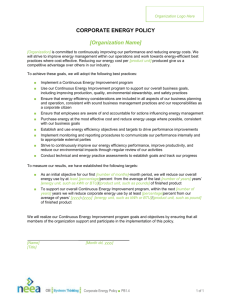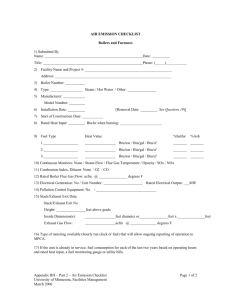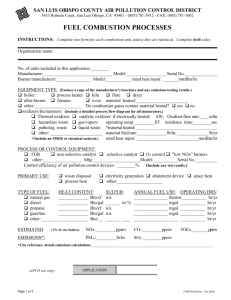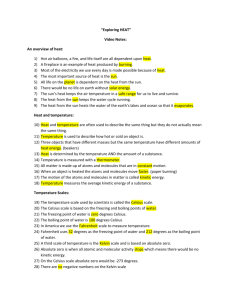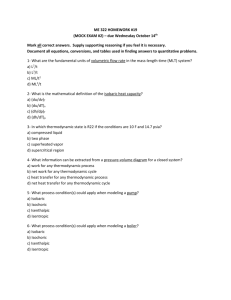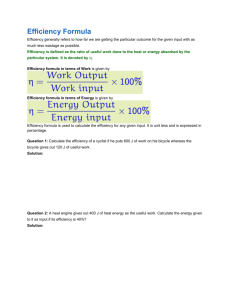A Mathematical Proof of Carnot Excedence
advertisement
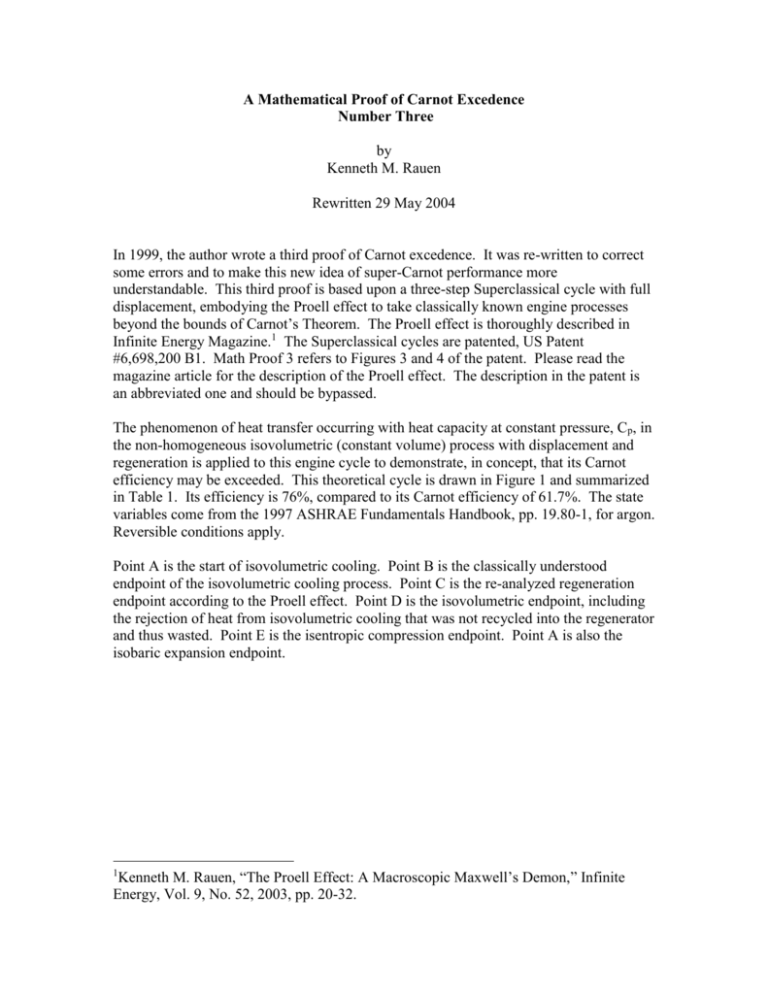
A Mathematical Proof of Carnot Excedence Number Three by Kenneth M. Rauen Rewritten 29 May 2004 In 1999, the author wrote a third proof of Carnot excedence. It was re-written to correct some errors and to make this new idea of super-Carnot performance more understandable. This third proof is based upon a three-step Superclassical cycle with full displacement, embodying the Proell effect to take classically known engine processes beyond the bounds of Carnot’s Theorem. The Proell effect is thoroughly described in Infinite Energy Magazine.1 The Superclassical cycles are patented, US Patent #6,698,200 B1. Math Proof 3 refers to Figures 3 and 4 of the patent. Please read the magazine article for the description of the Proell effect. The description in the patent is an abbreviated one and should be bypassed. The phenomenon of heat transfer occurring with heat capacity at constant pressure, Cp, in the non-homogeneous isovolumetric (constant volume) process with displacement and regeneration is applied to this engine cycle to demonstrate, in concept, that its Carnot efficiency may be exceeded. This theoretical cycle is drawn in Figure 1 and summarized in Table 1. Its efficiency is 76%, compared to its Carnot efficiency of 61.7%. The state variables come from the 1997 ASHRAE Fundamentals Handbook, pp. 19.80-1, for argon. Reversible conditions apply. Point A is the start of isovolumetric cooling. Point B is the classically understood endpoint of the isovolumetric cooling process. Point C is the re-analyzed regeneration endpoint according to the Proell effect. Point D is the isovolumetric endpoint, including the rejection of heat from isovolumetric cooling that was not recycled into the regenerator and thus wasted. Point E is the isentropic compression endpoint. Point A is also the isobaric expansion endpoint. Kenneth M. Rauen, “The Proell Effect: A Macroscopic Maxwell’s Demon,” Infinite Energy, Vol. 9, No. 52, 2003, pp. 20-32. 1 Math Proof 3 post-patent 29 May 04 2 Figure 1 See the attached photocopy of the 1997 ASHRAE Fundamentals Handbook, p. 19.80, pressure-enthalpy plot of argon as page 3, with the cycle state points highlighted as red dots. Math Proof 3 post-patent 29 May 04 3 Math Proof 3 post-patent 29 May 04 4 Table 1 State Variables Process isoV isoV isoV isoS isoP Point Pt A Pt B Pt C Pt D Pt E T, R 993 556 409 380 556 P, psia 40.0 22.4 16.7 15.6 40.0 V, 6.67 cubic ft / # 6.67 6.67 6.67 3.7 H, 123.5 Btu / # 68.8 50.8 47.0 68.8 S, 0.952 Btu / # R 0.909 0.886 0.900 0.880 U, 74.1 Btu / # 41.2 30.2 27.8 41.4 Pt A Math Proof 3 post-patent 29 May 04 5 Point A Given: P = 40.0 psia, V = 6.67 cu ft/#. Corresponding state variables read from the PH diagram, T = 993R, H = 123.5 Btu/#, S = 0.952 Btu/#R, U = 74.1 Btu/#, where U is calculated by U = H PV, and the units of pressure and volume are converted to Btu by a factor of 0.185 Btu / psia cu ft. Point D Given: Isovolumetric cooling at V = 6.67 cu ft/# to S = 0.880 Btu/#R. This corresponds to, T = 380R, P = 15.6 psia, H = 47.0 Btu/#, U = 27.8 Btu/#. Point E Given: Isentropic compression from Point D at S = 0.8800 Btu/# to P = 40.0 psia. This corresponds to, T = 556R, V = 3.7 cu ft/#, H = 68.8 Btu/#, U = 41.4 Btu/#. Math Proof 3 post-patent 29 May 04 6 Point B Given: Isovolumetric cooling from Point A to the temperature of Point D, the point at which classical isovolumetric cooling would end at, due to the regenerator’s lowest temperature: V = 6.67 cu ft and T = 556 R. This corresponds to, P = 22.4 psia, H = 68.8 Btu/#, S = 0.909 Btu/#, U = 41.2 Btu/#. The lowest temperature of the regenerator is not in thermal contact with the external low temperature reservoir, the heat sink at Point D. The cold side gas volume is adiabatically isolated from the regenerator but isothermally connected to the low temperature reservoir. Isovolumetric Cooling This cycle uses the regenerator to recycle heat from isoV cooling to isoP heating. The classical isoV heat rejected to the regenerator is, Uab = 41.2 74.1 = 32.9 Btu/#. Argon’s heat capacity ratio, , is 1.67 in the temperature range of this cycle. The selfrefrigeration according to the Proell effect is, SR = ( 1)(Uab), = (0.67)(32.9 Btu/#), = 22.0 Btu/#. Half of this appears in the cold zone, due to the equal energy split of full displacement between the hot and cold zones, as explained in depth in the Infinite Energy article, SRcold = 11.0 Btu/#. It goes into the regenerator. The other half of the self-refrigeration, on the hot side, takes heat from the high temperature reservoir and places it into the regenerator because the hot side of the engine is isothermal, SRhot = 11.0 Btu/#. The isothermal condition of the hot side of the engine, including the regenerator hot end, is necessary to avoid an irreversibility in the regenerator. The Proell effect hot side cooling otherwise would introduce cooler gas into the regenerator, decreasing the Math Proof 3 post-patent 29 May 04 7 regenerator’s high temperature and causing gas entering it at the hot reservoir’s temperature to fall in temperature. The total heat stored in the regenerator is, QisoVregen = Uab + SRcold + SRcold, = (32.9 Btu/#) + 2(11.0 Btu/#), = 54.9 Btu/#. Point C The heat collected inside the regenerator from constant volume cooling does not cool the gas to Point D; it stops at Point C. More heat is rejected from the gas than is recycled, and that heat difference is wasted. The specific volume at Point C is still the same, 6.67 cu ft/#. The internal energy of the gas becomes, Uc = Ub + SRcold, = 41.2 Btu/# + (11.0 Btu/#), = 30.2 Btu/#, as the self-refrigeration was taken from the internal energy of the gas in the cold zone. By the ASHRAE table for properties at one atmosphere, Cp and at 0F allow Cv to be estimated, which gives the temperature of Point C, Tc = Tb + (Ubc)/(Cv = Cp/), = (556R) + (30.2 Btu/# 41.2 Btu/#)/(0.125 Btu/#F / 1.67), = (556R) + (147F), = 409R. From the pressure-enthalpy plot, H = 50.8 Btu/#, S = 0.886 Btu/#R. Pressure is calculated from H = U + PV, P = 16.7 psia. Isovolumetric Cooling Completed The waste heat of the cycle comes from only the rejected heat of isovolumetric cooling, from Point C to Point D. Since heat is passed under constant volume, it is, Math Proof 3 post-patent 29 May 04 8 Qout = Ucd, = (27.8 Btu/#) – (30.2 Btu/#), = –2.4 Btu/#. Isentropic Compression Since this engine operates with a confined gas that does not flow in or out of the cylinder, being a control mass, so to speak, then flow work does not apply and the isentropic heat transfer into work is defined by only the change in the internal energy, Wcomp = Ude, = (41.4 Btu/#) – (27.8 Btu/#), = 13.6 Btu/#. Isobaric Expansion The constant pressure expansion with full displacement through the regenerator transfers heat from the regenerator to the gas, Hea = (123.5 Btu/#) – (68.8 Btu/#), = 54.7 Btu/#. The expansion work is, Wexp = PVea, = (40 psia)((6.67 cu ft/#) – (3.7 cu ft/#))(0.185 Btu / cu ft psi), = 22 Btu/#. Cycle Summary For a balanced cycle, the heat released by the regenerator must equal the heat absorbed by the regenerator, QisoPregen = –QisoVregen, = 54.9 Btu/#. The heat input during isobaric expansion is, Qin = Hea – QisoPregen, = (54.7 Btu/#) – (54.9 Btu/#), = zero, Math Proof 3 post-patent 29 May 04 9 indicating the entire cycle’s heat input comes from the heat influx to the regenerator from the high temperature reservoir during isovolumetric cooling, caused by self-refrigeration of the hot side from the Proell effect, and isothermal conditions of the engine’s hot side, Qin = SRhot, = 11.0 Btu/#, the negative sign indicating the heat flow is compensation for the seemingly exothermic cooling of the gas in the hot side in the isovolumetric process. Ultimately, the heat input in the isovolumetric process is an endothermic flow to the gas in the isobaric process, as provided by the regenerator. The net flow of energy through the cycle, as accounted for by the heat flows, identifies the net work as, Wnet = Qin + Qout, = (11.0 Btu/#) + (–2.4 Btu/#), = 8.6 Btu/#. Another way to check the net work is, Wnet = Wexp + Wcomp, = (22 Btu/#) + (13.6 Btu/#), = 8.4 Btu/#, which is very close, considering that most state variables were derived by visual interpolation of the pressure-enthalpy plot. The efficiency of the cycle is, = (Wnet)/(Qin), = (8.4 Btu/#)/(11.0 Btu/#), = 76%. The Carnot efficiency is, c = (Ta Td)/(Ta), = (993 380R)/(993R), = 61.7%. This cycle exceeds Carnot’s Theorem. More heat is recycled than classically allowed. The exceptional recycling is due to exploitation of the thermal separation created by the Proell effect, a macroscopic Maxwell’s Demon. That separation, though conforming to the Second Law of Thermodynamics as a process in an isolated system, is used asymmetrically so that a net “uphill” heat flow is created inside the engine to increase the efficiency of the cycle. A practical application of the Proell effect is thus shown.
